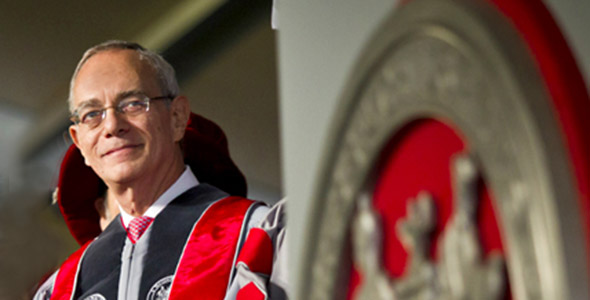Facing new facts from MIT's past
A letter from President L. Rafael Reif on MIT and the legacy of slavery

12 February 2018
To the members of the MIT community,
At MIT, we face facts, and we turn passionately toward the future. Today, however, we must attend to some newly uncovered facts from our past.
A distinguished member of our history faculty, Professor Craig Steven Wilder is the leading authority on how the emergence and growth of American colleges and universities is entwined with the history of slavery. Last spring, I sought Craig’s advice on how MIT could best explore its historical connections in this realm. Based on our conversation, SHASS Dean Melissa Nobles and I immediately endorsed his proposal: to develop an ongoing undergraduate primary-research course, to be called “MIT and Slavery.”
Led by Professor Wilder and MIT’s archivist for reference services Nora Murphy, the class began last fall, meeting in the MIT archives. In December, the students presented to me what they have discovered so far.
Already, they have uncovered a range of evidence showing how MIT’s early decades were shaped by the post-Civil War process of reconstruction, from MIT-trained engineers rebuilding the South’s war-torn railroads to our links to many industries, from mining to textiles, that had depended directly or indirectly on labor from enslaved people. The students also found evidence of how the ugly racial attitudes of the day played out in student publications and even aspects of the curriculum. Perhaps the most jarring finding: an 1850 Virginia census document, which shows that before William Barton Rogers moved to Boston to found MIT, he and his wife, Emma, held six human beings as slaves.
The MIT News story and accompanying video offer more detail.
Through early conversations with various members of our community, I have already seen a range of reactions to and feelings about this news. As the research process continues this semester and beyond, we cannot know what we may find. But I am certain that we have nothing to fear from examining our past; understanding it better can only make us wiser. I have already learned a great deal from listening to other people’s perspectives on the findings, and I look forward to our reflecting on this new knowledge as a community.
In the 157 years since MIT’s founding, we have often celebrated William Barton Rogers for his creative vision as an educator and his tenacity in pushing to establish MIT. With this new evidence, and our ongoing commitment to learn more about the links between the institution of slavery and technical institutions like MIT, today we must start thinking together about how to tell a more complete version of our history.
Craig’s pioneering work as a historian has led him to become an expert on how US educational institutions have chosen to face and respond to their historical ties to slavery. As we face this work ourselves, we are extremely fortunate to have the benefit of his leadership.
Drawing on the experience of other institutions, and inspired by MIT’s signature spirit of openness, we believe the best way forward is for the members of our community to discuss and explore together how to address these new dimensions of our past. I am deeply grateful that Dean Nobles has agreed to lead us in this important work.
We will begin this ongoing dialogue with a review of the class and its initial findings:
MIT and the Legacy of Slavery: Reviewing the Early Findings
Friday, February 16
1:00-2:30 pm
MIT Media Lab, 6th floor (E14)
I hope many of you will be able to join Craig, Nora, Melissa and me — as well as the remarkable students from the “MIT and Slavery” class – as we come together to open this shared conversation. I’m also grateful to the Black Students' Union, the Black Graduate Student Association, the MIT Libraries and the School of Humanities, Arts and Social Sciences for joining with my office to organize this first event of our collective exploration.
I have an abiding trust in the good will and good sense of the MIT community. Together, we will make sure that reassessing these chapters of our history will leave us wiser, stronger and more unified – better equipped both to live together in the present and to help make a better world.
Sincerely,
L. Rafael Reif
President of MIT
Suggested links
MIT and Slavery
MIT News, 12 February 2018
Video, 12 February 2018
MIT and the Legacy of Slavery
by MIT historian Craig Steven Wilder
Review in The New York Times
Ebony and Ivy, by Craig Steven Wilder
MIT News, 24 September 2013Race and class
MIT historian Craig Wilder documents the manifold links between universities and the slave economy in colonial America.